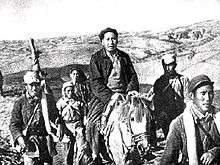The long march through the institutions

.jpg)

The long march through the institutions (German: der lange Marsch durch die Institutionen) is a slogan coined by student activist Rudi Dutschke to describe his strategy for establishing the conditions for revolution: subverting society by infiltrating institutions such as the professions. The phrase "long march" is a reference to the prolonged struggle of the Chinese communists, which included a physical Long March of their army across China.[1]
Influences
The main influence on Dutschke's thinking is commonly supposed to be the work of Italian communist, Antonio Gramsci, who, while imprisoned by Mussolini, wrote about cultural hegemony and the need for a "war of position" to establish the conditions for a revolutionary "war of manoeuvre".[2] Degroot also identifies Ernst Bloch as a major influence.[3] Bloch met Dutschke at Bad Boll in 1968 and admired his integrity and determination – qualities which he had written about in Das Prinzip Hoffnung (The Principle of Hope) as being essential for the achievement of utopia.[3]
Herbert Marcuse corresponded with Dutschke in 1971 to agree with this strategy, "Let me tell you this: that I regard your notion of the 'long march through the institutions' as the only effective way..."[4] In his 1972 book, Counterrevolution and Revolt, Marcuse wrote
To extend the base of the student movement, Rudi Dutschke has proposed the strategy of the long march through the institutions: working against the established institutions while working within them, but not simply by 'boring from within', rather by 'doing the job', learning (how to program and read computers, how to teach at all levels of education, how to use the mass media, how to organize production, how to recognize and eschew planned obsolescence, how to design, et cetera), and at the same time preserving one's own consciousness in working with others.
See also
References
Sources
- Dalton, Russell (1987), "Generational Change in Elite Political Beliefs: The Growth of Ideological Polarization", The Journal of Politics, Vol. 49 (4): 976–997, doi:10.2307/2130780
- Davidson, Carl (2006), Strategy, Hegemony and the 'Long March': Gramsci's Lessons for the Antiwar Movement, ISBN 9781430329589
- Degroot, Gerard (2014), "Rudi Dutschke's Long March", Student Protest: The Sixties and After, Routledge, ISBN 9781317880493
- Flechtheim; Rudzio; Vilmar; Wilke (1980), Der Marsch der DKP durch die Institutionen: Sowjetmarxistische Einflußstrategien und Ideologien, Frankfurt am Main: Fischer-Taschenbuch-Verlag, ISBN 3-596-24223-1
- Horchem, Hans Josef (1975), Extremisten in einer selbstbewussten Demokratie, Freiburg im Breisgau: Herder, ISBN 3-451-07515-6
- Horchem, Hans Josef (1973), "The Long March Through the Institutions", Conflict Studies, Institute for the Study of Conflict, Vol. 33
- Marcuse, Herbert (2014), Marxism, Revolution and Utopia: Collected Papers of Herbert Marcuse, Vol. 6, Routledge, ISBN 9781317805564
- Kimball, Roger (2001), The Long March: How the Cultural Revolution of the 1960s Changed America, Encounter Books, ISBN 978-1893554306
- Niedenhoff, Horst-Udo (1979), Auf dem Marsch durch die Institutionen, Köln: Deutscher Instituts-Verlag, ISBN 3-88054-325-9
- Ross, Robert (2010), "Reflections on the Sociology Liberation Movement of 1968", Crisis, Politics and Critical Sociology, BRILL, ISBN 9789004179486
- Rudorf, Reginald (1994), Die vierte Gewalt, Frankfurt am Main: Ullstein, ISBN 3-548-36635-X
- Schelsky, Helmut (10 December 1971), "Die Strategie der "Systemüberwindung". Der lange Marsch durch die Institutionen.", Frankfurter Allgemeine Zeitung
- Waldman, Eric (1976), Deutschlands Weg in den Sozialismus, Mainz: V. Hase + Koehler, ISBN 3-7758-0922-8
Citations
- ↑ Kimball 2001, p. 15.
- ↑ Davidson 2006, p. 261.
- 1 2 Degroot 2014, p. 110.
- ↑ Marcuse 2014, p. 336.
